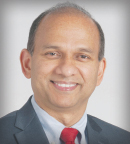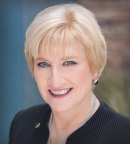In May 2023, The ASCO Post launched a new feature, View From the Top: The Future of Cancer Care Delivery, which explores how leaders in oncology are developing strategies to ensure continued innovative oncology care in an ever-changing health-care environment. In this installment, Guest Editor Jame Abraham, MD, FACP, talked with Barbara L. McAneny, MD, FASCO, MACP, founder and Chief Executive Officer of the New Mexico Cancer Center in Albuquerque and Gallup; Founder and Chair of the National Cancer Care Alliance; and Past President of the American Medical Association.

Jame Abraham, MD, FACP

Barbara L. McAneny, MD, FASCO, MACP
In addition to these positions, Dr. McAneny was a founding member of Oncology Circle, which includes a group of oncology practices using data to promote best practices. Dr. McAneny’s interest in using data to improve practice sustainability began when she was appointed to the Centers for Medicare & Medicaid Services (CMS) Practicing Physicians Advisory Council in 2002.
In 2012, Dr. McAneny received a nearly $20 million grant from the CMS Innovation Center to develop a community oncology medical home model and implement the model in seven practices across the country, with the goal of improving patient outcomes and patient satisfaction while significantly reducing medical costs. The care model, known as Community Oncology Medical Home (COME HOME), has proved to be successful; and the CMS based its Oncology Care Model, which is designed to provide higher quality and more highly coordinated oncology care at the same or lower cost to Medicare, on the principles of COME HOME. As of 2022, there were 122 practices and five commercial payers participating in the Oncology Care Model.1
Dr. McAneny is an ASCO fellow and a former member of ASCO’s Board of Directors. She also has served as a member of the Community Oncology Alliance Board of Trustees and on the Board of Directors of the Cancer Center Business Summit.
In this conversation, Dr. Abraham and Dr. McAneny discuss how inflation, the rising cost of cancer care, the oncology workforce shortage, and ongoing chemotherapy drug shortages are impacting the delivery of cancer care and what can be done to address these problems. The interview has been edited for length and clarity.
Overcoming Oncology’s Greatest Barriers to Patient Care
Dr. Abraham: What do you consider to be our greatest challenges in the post-COVID era, especially regarding inflation, the oncology workforce shortage, and the chemotherapy drug shortage, and how are they affecting cancer care delivery?
Dr. McAneny: Let’s start with the workforce shortage, because it is a problem that has concerned me since I was a member of ASCO’s Board of Directors a decade ago. In 2006, ASCO commissioned a study on the supply of and demand for oncology services through 2020; it found that demand was expected to increase by 48%, but supply of services oncologists provided would rise by only 14%. This translated into a shortage of 9.4 to 15.0 million visits, or 2,550 to 4,080 oncologists—approximately one-quarter to one-third of the 2005 supply.2
This is a serious problem. Fortunately, we are now able to keep patients with cancer alive longer, but that requires a lot of oncology expertise, and we do not have a sufficient number of oncologists to meet the increasing patient demand. The ASCO study was completed before advances in cancer immunotherapy, so the numbers of the oncology workforce shortage and increasing patient demand are probably underestimated.
We have to figure out how to work smarter and have up-to-date information on gene mutations and new therapies at our fingertips to provide patients with the most effective care, but how do we do that? One solution is through an electronic pathway product Dana-Farber Cancer Institute is creating for its physicians; it provides oncologists with the best treatments currently available for each type of cancer and for every stage of disease (www.dana-farber.org/about/quality-safety/improve-innovate/pathways).
I am Chair of the National Cancer Care Alliance, and we are working with the Quality Cancer Care Alliance to implement pathway products for our members to have the information available at the point of care. We have to democratize that information, so all patients with cancer are assured of getting the absolute best current options for their disease. This type of decision support needs to be embedded into our electronic medical records to make us efficient in providing optimal care for every patient.
Accessing Information for Every Cancer Type at the Point of Care
Dr. Abraham: Are the current efforts by ASCO and the National Comprehensive Cancer Network (NCCN) to democratize treatment guidelines closing the gaps in physicians’ ability to access the latest information on cancer care, even if that information is outside their area of specialty?
Dr. McAneny: Their efforts are a great start. But if oncologists are going to be seeing 25 to 30 patients a day with a variety of cancer types, which will become necessary as the workforce continues to shrink and patient demand increases, we will need information on every cancer type at the point of care. Electronic medical records will have to evolve to include ASCO and NCCN Clinical Practice Guidelines in Oncology (NCCN Guidelines®) or other pathway products. Medical oncologists who specialize in treating breast cancer because that disease makes up the majority of their patient population may also have a minority of patients with other cancer types, and that means those oncologists will need decision-support tools to treat a variety of cancers. No one can know all the current ASCO and NCCN Guidelines on obtaining the genomic mutations of a specific cancer and determining the most effective treatment without a process to democratize the information needed. Having this information at the point of care will be key for managing the increasing number of patients in the future.
Reining in the Cost of Care
Dr. Abraham: One study finds that the average cost of cancer care and drugs is more than $42,000 in the year after a cancer diagnosis, and that overall national costs in 2015 were $183 billion, with projected increases of 34% to $246 billion by 2020, based only on population growth.3 What can be done to contain costs in care? Is this exponential growth in cancer care sustainable?
Dr. McAneny: First, pharmacy benefit managers add 50% onto the cost of oral chemotherapy drugs after they leave the manufacturer. Are the manufacturers entirely innocent? No, they are not, but at least they are producing a product. I would start with eliminating the expensive middlemen who provide little value to cancer care, because we have to stop letting corporations profiteer off the cost of cancer drugs.
Second, we have to transform the way research is done, which makes it incredibly expensive to bring a new drug to market. The National Cancer Care Alliance and the Quality Cancer Care Alliance are working to create a research process that takes into account real-world data and makes clinical trials more inclusive to increase evidence-based advances in therapies that will generate more generalizable data to better inform clinical decision-making. The U.S. Food and Drug Administration has expressed interest in requiring clinical trials to be more inclusive, so this initiative is timely.
“If oncologists are going to be seeing 25 to 30 patients a day with a variety of cancer types..., we will need information on every cancer type at the point of care.”— BARBARA L. McANENY, MD, FASCO, MACP
Tweet this quote
The high cost of cancer care has the potential to disenfranchise poor people or people of color. We need to focus on delivering care in the most cost-effective way possible, and the physician fee schedule practices are much less expensive than hospital outpatient practices.
For example, if I sold my independent physician fee schedule practice to a local hospital, and I saw the same patient I used to see in my practice, performed the exact same exam, and prescribed the exact same drugs, it would cost Medicare double what it was paying me. And it would cost commercial payers three to five times as much. The literature shows the consolidation of oncology care into hospital-based systems is making cancer care more expensive, and that is not good.
I applaud the Federal Trade Commission for trying to rein in hospital and health-plan mergers. We are going to have to look at paying accurately instead of paying a large site of service differential. We have to figure out what the accurate cost of managing a patient on a specific drug regimen should be, and what is the ideal cost to deliver that regimen, including workforce costs and medical practices’ and centers’ overhead. Until we know what it truly costs to deliver care, we cannot set prices for our services that are fair and sustainable.
For 17 years, I have been taking care of some of the poorest patients in America on the Navajo Nation in New Mexico, but health care is a business. We have to keep the lights on. However, medicine is also a calling, and I worry we are losing that part of our profession and possibly our most precious resource. We cannot afford to lose that sense of calling.
Maintaining Global Leadership in Research
Dr. Abraham: Thank you for saying that. The practice of medicine is a calling. What really sets the U.S. health-care system apart from the rest of the world is our innovation in research. How do we continue that global leadership in research when we have all these other competing issues?
Dr. McAneny:I am proud to be a physician in the United States, but we definitely have the most expensive health care and worse patient outcomes of other high-income countries. Other countries spend more on disease prevention and on the social determinants of health, including good housing, good nutrition, and education. We spend more on delivering medical care.
“Health care is a business. We have to keep the lights on. However, medicine is also a calling.... We cannot afford to lose that sense of calling.”— BARBARA L. McANENY, MD, FASCO, MACP
Tweet this quote
When I was President of the American Medical Association and traveled to other countries for conferences, presidents of the country’s medical associations would talk about the issues they had. But, invariably, their speech would end with, “At least we’re not the U.S. health-care system,” and then they would introduce me to talk about our health-care system. I could not argue with their analysis. We do spend more money on health care than other countries, but we spend it in the wrong places.
Now, who is going to have the political will to stand up to the pharmacy benefit managers and other health-care entities and say, “You don’t deserve to make billions of dollars of profit when people cannot get the health care they need and deserve?” The medical profession needs to stand up and say, “This profiteering has to stop. Our job is to provide high-quality care to patients, not make more money for rich people.”

One example of how I reduced cost in my own practice of 27 physicians and 280 employees is by having a self-insured health plan, and over the past 6 years, my premiums have been flat. This past year, I got rid of copays for office visits, and this year, I got rid of copays for drugs; my employees’ maximum out-of-pocket costs, even when I sent them out-of-state for specialty care, was $2,000 a year. So, reining in health-care costs can be done. There are ways to fix this broken health-care system.
Over the years, I have learned that when physicians link arms and we put aside our differences about being in academic or private practice and in different specialties, and work together for the good of our patients, we can be an unstoppable force. It is time for us to step up and use that moral high ground to say, “This is what health care in our country needs to look like, and we need to work together to accomplish that goal.”
The Future of Cancer Care
Dr. Abraham: Despite all the challenges we face, what excites you about the future in oncology care?
Dr. McAneny:What excites me about the future is organizations such as the National Cancer Care Alliance and Quality Cancer Care Alliance to help us come together as independent oncology practices. We do not have to run each other’s practices or micromanage one another. Practices can join together as allies and do big things together, including research or data projects or drug purchasing; but we can remain small and nimble when we need to fit into our communities and operate efficiently to provide care for patients.
I am excited about working with my friend Sibel Blau, MD, an oncologist/hematologist in Tacoma, Washington, to determine how to design clinical trials that are truly clinically relevant to the patients we treat. Within the National Cancer Care Alliance and the Quality Cancer Care Alliance, we are working to see what we can develop to provide a place for physicians to go back to being in charge of their own lives and practices, armed with the information they need to do the best job for their patients, without having to worry about practice expenses. This is what gets me up in the morning.
DISCLOSURE: Dr. McAneny reported no conflicts of interest.
REFERENCES
1. Centers for Medicare & Medicaid Services: Oncology Care Model. Available at www.cms.gov/priorities/innovation/innovation-models/oncology-care. Accessed January 3, 2024.
2. Erikson C, Salsberg E, Forte G, et al: Future supply and demand for oncologists: Challenges to assuring access to oncology services. J Oncol Pract 3:79-86, 2007.
3. Mariotto AB, Enewold L, Zhao J, et al: Medical care costs associated with cancer survivorship in the United States. Cancer Epidemiol Biomarkers Prev 29:1304-1312, 2020.
Dr. Abraham is Chairman of the Department of Hematology and Medical Oncology at Cleveland Clinic and Professor of Medicine at Lerner College of Medicine.

